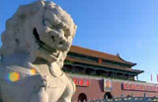The most elite POW camp in the world
Updated: 2015-05-06 07:53
By He Na and Han Junhong(China Daily)
|
|||||||||||
Northeast China played host to some of the highest-ranked Allied officers and civilian officials during the years leading up to the end of World War II. However, none of them were there of their own volition. Instead, they were being held by the Japanese. He Na and Han Junhong report from Liaoyuan, Jilin province
A number of old, redbrick, Japanese-style bungalows stand on a northerly hill at the former Garrison Command Headquarters in Liaoyuan, Jilin province, and hidden among them is an inconspicuous house dating to the 1930s.
At one time, the house was part of an enclave of similar buildings, but now it's the only one remaining, and although the peeling walls and rotten roof beams have altered its external appearance, the things that happened there and the stories arising from those events will live on, because this building holds a unique place in Chinese history.
It's one of the few visible reminders of the Liaoyuan Prisoner of War camp, and although many locals are unaware that the house exists, those that do find it hard to believe 34 high-ranking Allied officers, the deposed governor of Hong Kong and other top officials were imprisoned nearby during World War II.
The prisoners included a number of world-famous military names, such as General Jonathan Wainwright, commander of the Allied forces in the Philippines, Major General George Moore, former commander of the Philippine military harbor defenses, and two other Philippines' veterans, Brigadier General William E. Brougher and Major General George Parker. The men were held from autumn 1944 until the camp was liberated in August 1945.
Wainwright is perhaps best remembered from photos and footage showing the tall, thin, elderly soldier standing behind General Douglas MacArthur aboard the USS Missouri, watching as his compatriot officially accepted the surrender of Japan on Sept 2, 1945.
"As the place where the highest-ranking Allied POWs were held, the camp has huge historical value," said Wei Dong, curator of the Liaoyuan High-Ranking Allied POWs Camp Museum, which is set to open later this year.
Secret history
Researchers such as Wei owe a huge debt of gratitude to a US solider, the late Hal Leith, who was one of a team dispatched by the US Office of Strategic Services to liberate the senior officers. The experience lingered in Leith's mind long after he returned to the US, and he visited China many times in the years that followed.
"If it were not for Leith's 12 postwar visits to Northeast China to look for the camp, the buildings and other features would have been demolished, and the stories of what happened more than seven decades ago would be unknown," Wei said.
Qu Daode, deputy Party chief at the Liaoyuan Business School, who has spent many years researching the camp's history, said the Japanese had a hidden agenda for the prisoners: "Wainwright and the other high-ranking officers were only held at Liaoyuan for less than a year, but during those months of captivity the Japanese planned to use them as important bargaining chips to blackmail the Allies and control the progress of the war."
The museum, which has secured investment of 30 million yuan ($4.8 million), is still under construction, but is expected to open to the public in August.
"Sadly, Hal Leith, the biggest contributor to this memorial, passed away two years ago, so we won't have the honor of inviting him to the opening ceremony," Qu said.
According to Wei, the camp's story really begins with the Japanese attack on Pearl Harbor in December 1941, because the date marks the beginning of the Pacific War. The attack was quickly followed by attacks on Allied forces in Southeast Asia.
"Facing sudden attack, and severely underprepared, the Allied forces were fighting in extreme conditions. They lacked supplies, and disease was rife. To minimize the number of casualties, Wainwright ordered his men in the Philippines to lay down their arms at the island of Corregidor in May 1942 and surrender," he said.
In the three years that followed, the Japanese built 115 camps in Asia to house 200,000 Allied POWs. Liaoyuan, an offshoot of the Mukden camp, was designated to hold the top officers.
"The founding of the camp not only raised China's profile in the world fight against fascism, but also highlighted the friendship that existed between China and a number of other nations. The camp has great potential and value in terms of academic research, and we have found a huge number of artifacts that show how life was for the senior officers held there during the war," Wei said.
Days in captivity
According to Li Jun, deputy director of the Liaoyuan Cultural Heritage Bureau, the camp was built in 1931 on the site of the former northern barracks of the Japanese Imperial Army. Before it was transformed into a POW camp, the Japanese used the complex as a base for the interrogation and torture of Chinese soldiers.
The buildings that housed the high-ranking POWs were on the east side of the barracks. The high walls were laced with live electric cables and searchlights were set up in the guard towers.
"The Japanese also raised more than 20 dogs that ran around the place. The local residents regarded it as a den of murderers, and rather than pass close by the gates, they always made a long detour," he said.
The news that a museum was being founded attracted the attention of historians and scholars from across China, who made great contributions to the protection of the site and helped to collect a vast amount of firsthand information.
When construction began in 2008, the workers discovered two hidden tunnels and many artifacts. "We found tools, such as shovels and picks, bowls, food cans, beer bottles, some arms such as rifles and bullets, and medical syringes. They have already been added to the list of first-class cultural relics in Jilin," Li said.
In 2010, Wei led a team to Wainwright's hometown in the US to interview his family and gather more information about the camp and the conditions in which the POWs were held. Wainwright's family donated a copy of his memoir, General Wainwright's Story, and some of his belongings to the museum. "As an important site in the global battle against fascism, the museum will become a patriotic education base to remind people of the brutality of war and the importance of peace," Wei said.
Despite his status as the highest-ranking POW, Wainwright was treated extremely badly. "Many times during my long rot in captivity, I wondered how the Japanese were capable of their gross inhumanities," he wrote in his memoir.
Although conditions were harsh in Liaoyuan, it wasn't the worst of the camps. The words most used by survivors of nearby Shenyang camp were "hunger", "cold", "disease" and "brutality", according to Jing Xiaoguang, director of the Shenyang 9.18 Historical Museum. Jing said one of the prisoners, Ralph Griffith from the US, told him that the food was so disgusting that even the pigs refused to eat it.
Hao Liansheng, 79, lived near Liaoyuan camp when he was a child.
"I was at primary school in 1945 and our teacher, who was Japanese, knew the guards in the camp. He once took us there to help pull up weeds. I still remember the Japanese soldiers carried guns and wore bullet belts around their waists," he told Liaoshen Evening News in 2010.
"The Japanese warned us not to wander around, but when we were leaving in the afternoon I saw several foreigners - Europeans - walking around not far away, with the Japanese standing close behind them. The men weren't wearing military uniforms, they wore suits, so I guessed they must be important officials," he said.
Endgame
Qu said: "By 1945, the Japanese army was losing ground in most of China, and victory was almost assured. But Japan blocked the news from the POWs because it wanted to use them to blackmail the Allies and save the day."
The Japanese also asked Wainwright to write a letter to the US government on behalf of Japan, but he refused, he added.
It wasn't until the US sent a team to liberate the camp that the prisoners' days in hell came to an end.
Qu recalled that Leith had told him that Wainwright was extremely anxious when they met, because he was concerned that the US government and people would despise him for surrendering in the Philippines.
The POWs left Liaoyuan on Aug 24, 1945. It was the rainy season and the cars became bogged down in the muddy roads. According to Qu, Leith once told him, "Chinese along the road gave them water, food and helped them free cars that occasionally became trapped in the deep mud."
After the war, Wainwright wrote of his gratitude to the local people: "Without the help of the Chinese, I wouldn't have survived to leave, even though I had been rescued."
Liu Mingtai contributed to this story.
Contact the writers through hena@chinadaily.com.cn
(China Daily 05/06/2015 page6)
Today's Top News
Reasons behind Russia's high-profile V-Day celebrations
Wang Jianlin: Asia's richest man
China regulator denies Siemens bribery probe
Milan-Shanghai flight to 'establish important bridge'
Xi meets visiting KMT chairman
Siemens healthcare unit probed by China regulator for bribery
UK urged to ease up on visa curbs
Chinese president to visit Russia, Kazakstan, Belarus,attend WWII celebration in Moscow
Hot Topics
Lunar probe , China growth forecasts, Emission rules get tougher, China seen through 'colored lens', International board,
Editor's Picks

|

|

|

|

|

|






